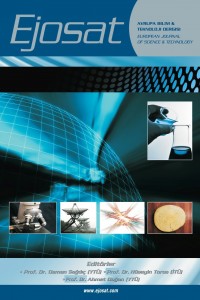Öz
Foundries are one of the most important segments of the society, since they provide the production of important components in industry. In foundries, the molten materials obtained by melting different elements and combining them in some certain proportions, are subject to various procedures, and are given the desired shape by molding. The produced castings are used in many different areas such as automotive and weapon sector, aviation and maritime industry, and so on. Meanwhile, manually realizing the quality and standardization procedures of the manufactured cast irons that have different properties based on the user requirements, by the engineers in industry causes serious loss of labor, time and cost.
Nowadays, the fast-growing technology diversifies the needs of users day by day. At this point, accelerating the quality process not only expedites all the following processes but also minimizes the loss of labor, time and cost. Considering this, a computer-aided system based on the nodularity and sphericity values of ductile cast iron is developed in this study. Therefore, 30 microscopic images of varying quality ductile cast iron samples, which were produced in a Casting Factory being operated in Konya Organized Industrial Zone, is utilized. Specifically, the microscopic images are segmented by using image processing methods, and then the location and number of the nodules in micro-structures and sphericity of their shapes are calculated. Hence, it has been possible to analyze the ductile cast iron samples in computer environment, and a preliminary study has been presented to detect their qualities automatically. The realized simulations show that sphericity value of the micro-structures can be presented quantitatively with image processing techniques, and number of the nodules can be detected with the accuracy rate of 95,45%.
Anahtar Kelimeler
Image Processing Quality Ductile Cast Iron Sphericity Nodularity Segmentation
Kaynakça
- Kopardaker P., Mital A. ve Anand S., (1993). Integrated Manufacturing Systems, vol.4, no. 1, 18-29.
- Bubenko, L., Konecna, R. ve Nicoletto, G., (2009). Observation of fatigue crack paths in nodular ast iron and ADI microstructures, Materials Engineering, 16, 13-18, Slovakia.
- Demirlek M., (2013). Küresel Grafitli Dökme Demirlerin Yüksek Çevrimli Yorulma Davranışına Silisyum Oranının Etkisi, Yüksek Lisans Tezi, İstanbul Teknik Üniversitesi Fen Bilimleri Enstitüsü, İstanbul.
- Swain, S. K., (2008). Effect of Chemistry and Processing Variables on the Mechanical Properties of Thin-wall Ductile iron castings, Yüksek Lisans Tezi, National Technology of University, Rourkela.
- Khalil-Allafi, J. ve Amin-Ahmadi, B., (2011). İnfluence of mold preheating and silicon content on microstructure and casting properties of ductile iron in permenant mold, Journal of iron and steel research, İnternational, 18,34-39, Tahran,.
- Shinde, V. D., Ravi, B. ve Narasimbhan, K., (2012). Solidification Bhaviour and mechanical Properties of ductile Iron castings and varying thickness, International Journal of Cast Metals Research, 25, 364-373, India.
- Olsson, A., (2011.). Fatigue strength of truck components in cast iron, Yüksek Lisans Tezi, Chalmers University of Technology, Göteborg.
- Çetin A., (2016). El Kitabı 02: Küresel Grafitli Dökme Demir, Türkiye.
Küresel Grafitli Dökme Demirin Nodülarite ve Küreselliğinin Görüntü İşleme Yöntemleri Kullanılarak Belirlenmesi
Öz
Dökümhaneler, endüstrideki önemli parçaların üretimini sağlamaları sebebiyle toplumun en önemli faaliyet eksenlerinden biridir. Dökümhanelerde, farklı elementlerin eritilmesi ve belli oranlarda birleştirilmesiyle elde edilen eriyik malzemeler, çeşitli işlemlere tabi tutulmakta ve kalıplanarak istenen şekle getirilmektedir. Üretilen dökümler, otomotiv ve silah sektörü, havacılık ve denizcilik endüstrisi gibi birçok farklı alanda kullanılmaktadır. Bununla birlikte, kullanıcıların ihtiyacına göre farklı özelliklerde üretilen dökme demirlerin kalite ve standardizasyon işlemlerinin sanayide mühendisler tarafından manuel olarak gerçekleştirilmesi ciddi iş gücü, zaman ve maliyet kayıplarına sebep olmaktadır.
Günümüzde hızla ilerleyen teknoloji, kullanıcıların ihtiyaçlarını her geçen gün daha da çeşitlendirmektedir. Bu noktada kalite süreçlerinin hızlandırılması, devamındaki bütün süreçleri hızlandırmakla kalmayacak; iş gücü, zaman ve maliyet kaybını da minimum seviyeye indirecektir. Bu durum göz önünde bulundurularak, bu çalışmada; küresel grafitli dökme demirin nodülarite ve küresellik değerleri baz alınarak bilgisayar destekli bir sistem geliştirilmiştir. Bunun için, Konya Organize Sanayi Bölgesinde faaliyet gösteren bir döküm fabrikasında çeşitli kalitelerde üretilen küresel grafitli dökme demir parçalarına ait 30 adet mikroskop görüntüsü kullanılmıştır. Temelde görüntü işleme metotlarından yararlanarak mikroskop görüntüleri segmente edilmiş, daha sonra mikro yapılardaki nodüllerin yeri, sayısı ve şekillerinin küreselliği hesaplanmıştır. Bu sayede küresel grafitli dökme demir parçalarının bilgisayar ortamında incelenmesi mümkün olmuş ve kalitelerinin otomatik olarak belirlenmesi adına bir ön çalışma ortaya konmuştur. Gerçekleştirilen simülasyonlar, görüntü işleme metotları ile mikroyapıların küresellik değerinin nicel olarak ortaya konabileceğini ve %95,45’lik doğruluk oranı ile nodül sayısının belirlenebileceğini göstermektedir.
Anahtar Kelimeler
Görüntü İşleme Kalite Küresel Grafitli Dökme Demir Küresellik Nodülarite Segmentasyon
Kaynakça
- Kopardaker P., Mital A. ve Anand S., (1993). Integrated Manufacturing Systems, vol.4, no. 1, 18-29.
- Bubenko, L., Konecna, R. ve Nicoletto, G., (2009). Observation of fatigue crack paths in nodular ast iron and ADI microstructures, Materials Engineering, 16, 13-18, Slovakia.
- Demirlek M., (2013). Küresel Grafitli Dökme Demirlerin Yüksek Çevrimli Yorulma Davranışına Silisyum Oranının Etkisi, Yüksek Lisans Tezi, İstanbul Teknik Üniversitesi Fen Bilimleri Enstitüsü, İstanbul.
- Swain, S. K., (2008). Effect of Chemistry and Processing Variables on the Mechanical Properties of Thin-wall Ductile iron castings, Yüksek Lisans Tezi, National Technology of University, Rourkela.
- Khalil-Allafi, J. ve Amin-Ahmadi, B., (2011). İnfluence of mold preheating and silicon content on microstructure and casting properties of ductile iron in permenant mold, Journal of iron and steel research, İnternational, 18,34-39, Tahran,.
- Shinde, V. D., Ravi, B. ve Narasimbhan, K., (2012). Solidification Bhaviour and mechanical Properties of ductile Iron castings and varying thickness, International Journal of Cast Metals Research, 25, 364-373, India.
- Olsson, A., (2011.). Fatigue strength of truck components in cast iron, Yüksek Lisans Tezi, Chalmers University of Technology, Göteborg.
- Çetin A., (2016). El Kitabı 02: Küresel Grafitli Dökme Demir, Türkiye.
Ayrıntılar
| Birincil Dil | Türkçe |
|---|---|
| Konular | Mühendislik |
| Bölüm | Makaleler |
| Yazarlar | |
| Yayımlanma Tarihi | 5 Ekim 2020 |
| Yayımlandığı Sayı | Yıl 2020 Ejosat Özel Sayı 2020 (ICCEES) |


